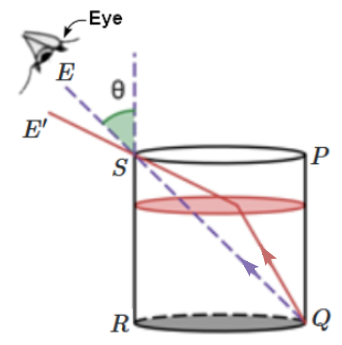Suppose that the lower half of the concave mirror’s reflecting surface in the given figure is covered with an opaque (non-reflective) material. What effect will this have on the image of an object placed in front of the mirror?

1.
the image will show only half of the object
2.
the image will show the whole of the object
3.
the intensity of the image will be low
4.
both (2) and (3)

The near point of a hypermetropic person is \(75\) cm from the eye. What is the power of the lens required to enable the person to read clearly a book held at \(25\) cm from the eye?
1. \(+2.67\) D
2. \(-1.25\) D
3. \(-2.67\) D
4. \(+1.25\) D
A rod of length \(10~\text{cm}\) lies along the principal axis of a concave mirror of focal length \(10~\text{cm}\) in such a way that its end closer to the pole is \(20~\text{cm}\) away from the mirror. The length of the image is:
1. \(15~\text{cm}\)
2. \(2.5~\text{cm}\)
3. \(5~\text{cm}\)
4. \(10~\text{cm}\)
To increase the angular magnification of a simple microscope, one should increase:
| 1. | the focal length of the lens |
| 2. | the power of the lens |
| 3. | the aperture of the lens |
| 4. | the object size |
If the critical angle for total internal reflection from a medium to vacuum is \(45^{\circ}\), the velocity of light in the medium is:
| 1. | \(1.5\times10^{8}~\text{m/s}\) | 2. | \(\frac{3}{\sqrt{2}}\times10^{8}~\text{m/s}\) |
| 3. | \(\sqrt{2}\times10^{8}~\text{m/s}\) | 4. | \(3\times10^{8}~\text{m/s}\) |

Then:
| 1. | \(\mu_{2}=\frac{1}{3},~\mu_{3}=\frac{1}{2}\) | 2. | \(\mu_{2}=3,~\mu_{3}=\frac{3}{2}\) |
| 3. | \(\mu_{2}=\frac{1}{3},~\mu_{3}=\frac{2}{3}\) | 4. | \(\mu_{2}=3,~\mu_{3}=2\) |
1. \(50\) cm
2. \(-50\) cm
3. \(-50/1.2\) cm
4. \(-50 \times1.2\) cm
| 1. | \(30\) cm | 2. | \(60\) cm |
| 3. | \(\dfrac{20}3\) cm | 4. | \(\dfrac{40}{3}\) cm |

1. \(\sqrt2\)
2. \(2\)
3. \(2\sqrt2\)
4. \(2+\sqrt2\)

1. \(\frac32\)
2. \(2\)
3. \(\sqrt{\frac32} \)
4. \(\sqrt2\)


